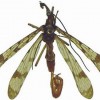 Have you seen this insect? No living individuals of Panorpa floridana ever have been observed. Knowledge of this species of scorpionfly is limited to five specimens from Alachua and Clay counties in northern peninsular Florida, the last one collected in 1982. This 4-page fact sheet was written by Louis A. Somma and James C. Dunford, and published by the UF Department of Entomology and Nematology, September 2012.
Have you seen this insect? No living individuals of Panorpa floridana ever have been observed. Knowledge of this species of scorpionfly is limited to five specimens from Alachua and Clay counties in northern peninsular Florida, the last one collected in 1982. This 4-page fact sheet was written by Louis A. Somma and James C. Dunford, and published by the UF Department of Entomology and Nematology, September 2012.
http://edis.ifas.ufl.edu/in949
Tag: Natural Area Insects
Eye Gnats, Grass Flies, Eye Flies, Fruit Flies Liohippelates spp. (Insecta: Diptera: Chloropidae) (EENY485/IN884)
High concentrations of eye gnats are common in areas that have loose sandy soils, especially in the southern United States, and are a great nuisance to humans and animals in rural towns as well as agricultural, recreational, and tourist areas. While they do not bite, they can transmit several diseases to humans and livestock, including human acute conjunctivitis (pink eye). This 6-page fact sheet focuses broadly on two species that are common in the southeastern region of the United States are L. pusio and L. bishoppi (Sabrosky). Written by Erika Machtinger and Phillip E. Kaufman and published by the UF Department of Entomology and Nematology, April 2011.
http://edis.ifas.ufl.edu/in884